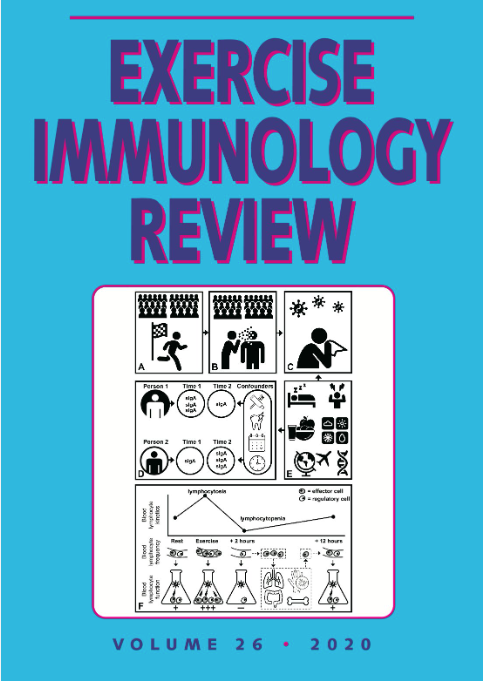焦虑和感知心理应激在运动后的免疫反应中起重要作用。
IF 3.8
4区 医学
Q2 IMMUNOLOGY
引用次数: 23
摘要
心理压力和运动压力改变免疫力有共同的途径。然而,目前尚不清楚心理应激是否在体内对运动的免疫反应中起作用。我们使用二苯基环丙烯(DPCP)皮肤致敏,研究了运动前报告的焦虑和感知心理压力与运动后体内免疫之间的关系。在一项随机设计中,64名完全熟悉的男性在运动前完成了广泛使用的心理工具,以评估状态焦虑和感知的心理压力,并在60% (30MI)或80% (30HI) V下跑步30分钟。o2峰值,在60% (120MI) V下120分钟。DPCP致敏前o2峰值或休息(CON)。皮肤对DPCP的召回是在致敏后4周对低剂量系列DPCP刺激的皮肤增厚反应。考虑运动后(R2 = 0.20;P < 0.01),多元回归显示运动前状态焦虑(STAI-S;Δr2 = 0.19;P < 0.01)和感知心理应激(ΔR2 = 0.13;P < 0.05)与运动后DPCP反应中度相关。在这些熟悉的个体中,运动前的STAI-S评分被认为是低到中等(中位数分裂;平均STAI-S低25,中34)。进一步的检查显示,在运动前报告轻度与中度状态焦虑的患者中,运动后DPCP反应(30MI、30HI或120MI)降低62%(真皮增厚的平均差异:-2.6 mm;95% CI: -0.8 ~ -4.4 mm;P < 0.01)。因此,结果表明,适度(相对于低)的状态焦虑和感知的心理压力对运动后的体内免疫有有益的影响。此外,生理应激(心率训练脉冲)与对DPCP的总皮肤反应之间的相关性也具有相当的强度(r = -0.37;95% CI: -0.05 ~ -0.62;P = 0.01),状态焦虑和对DPCP的总皮肤反应(r = 0.39;95% CI: 0.08 ~ 0.63;P < 0.01)。综上所述,运动前的状态焦虑和感知的心理应激水平对运动后体内免疫反应的强度起着重要的决定作用。这些结果表明,运动前的状态焦虑水平和运动时的生理应激水平与运动后的体内免疫反应具有相似的强度关系。未来的研究需要调查运动员、军事人员和其他从事高体力要求职业的人的运动免疫反应,这些职业比本研究报告的心理压力水平更高,例如与重要比赛、军事行动和重大生活事件有关。然而,目前的研究结果支持了运动科学家在检查对运动的免疫反应时应该考虑焦虑和心理压力的建议。本文章由计算机程序翻译,如有差异,请以英文原文为准。
Anxiety and perceived psychological stress play an important role in the immune response after exercise.
There are common pathways by which psychological stress and exercise stress alter immunity. However, it remains unknown whether psychological stress plays a role in the in vivo immune response to exercise. We examined the relationship between anxiety and perceived psychological stress reported before exercise and in vivo immunity after exercise using skin sensitisation with Diphenylcyclopropenone (DPCP). In a randomised design, sixty four, thoroughly familiarised, males completed widely used psychological instruments to assess state-anxiety and perceived psychological stress before exercise, and ran either 30 minutes at 60% (30MI) or 80% (30HI) V . O2peak, 120 minutes at 60% (120MI) V . O2peak or rested (CON) before DPCP sensitisation. Cutaneous recall to DPCP was measured as the dermal thickening response to a low-dose series DPCP challenge 4-weeks after sensitisation. After accounting for exercise (R2 = 0.20; P < 0.01), multiple-regression showed that pre-exercise state-anxiety (STAI-S; ΔR2 = 0.19; P < 0.01) and perceived psychological stress (ΔR2 = 0.13; P < 0.05) were moderately associated with the DPCP response after exercise. The STAI-S scores before exercise were considered low-to-moderate in these familiarised individuals (median split; mean STAI-S of low 25 and moderate 34). Further examination showed that the DPCP response after exercise (30MI, 30HI or 120MI) was 62% lower in those reporting low vs. moderate state-anxiety before exercise (mean difference in dermal thickening: -2.6 mm; 95% CI: -0.8 to -4.4 mm; P < 0.01). As such, the results indicate a beneficial effect of moderate (vs. low) state-anxiety and perceived psychological stress on in vivo immunity after exercise. Moreover, correlations were of comparable strength for the relationship between physiological stress (heart rate training impulse) and the summed dermal response to DPCP (r = -0.37; 95% CI: -0.05 to -0.62; P = 0.01), and state-anxiety and the summed dermal response to DPCP (r = 0.39; 95% CI: 0.08 to 0.63; P < 0.01). In conclusion, state-anxiety and perceived psychological stress levels before exercise play animportant role in determining the strength of the in vivo immune response after exercise. These findings indicate a similar strength relationship for the level of state-anxiety prior to exercise and the level of physiological stress during exercise with the in vivo immune response after exercise. Future research is required to investigate exercise-immune responses in athletes, military personnel and others in physically demanding occupations experiencing higher levels of psychological stress than those reported in this study e.g. related to important competition, military operations and major life events. Nevertheless, the present findings support the recommendation that exercise scientists should account for anxiety and psychological stress when examining the immune response to exercise.
求助全文
通过发布文献求助,成功后即可免费获取论文全文。
去求助
来源期刊

Exercise Immunology Review
医学-免疫学
CiteScore
16.00
自引率
0.00%
发文量
7
期刊介绍:
Exercise Immunology Review (EIR) serves as the official publication of the International Society of Exercise and Immunology and the German Society of Sports Medicine and Prevention. It is dedicated to advancing knowledge in all areas of immunology relevant to acute exercise and regular physical activity. EIR publishes review articles and papers containing new, original data along with extensive review-like discussions. Recognizing the diverse disciplines contributing to the understanding of immune function, the journal adopts an interdisciplinary approach, facilitating the dissemination of research findings from fields such as exercise sciences, medicine, immunology, physiology, behavioral science, endocrinology, pharmacology, and psychology.
 求助内容:
求助内容: 应助结果提醒方式:
应助结果提醒方式:


